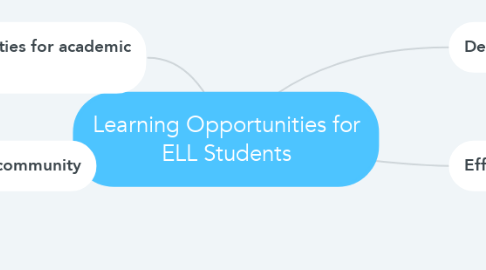
1. Opportunities for academic growth
1.1. Use language and cultural strength of students
1.1.1. Use student’s environments for discussions
1.1.2. Listen to student’s use of oral language to determine strengths
1.1.3. Choral reading, drama
2. Creating community
2.1. Classroom environment centered on respect and acceptance
2.1.1. Point out times that you, as a learner, understand something new from one of the students
2.2. Use of words
2.2.1. We, together, friends, teams, partners, neighbors
2.3. Student involvement over evaluation of achievement
2.3.1. Rather an intersection of involvement, challenge, success, collaborative learning, understanding of diversity
2.4. All students’ remarks and comments taken seriously and extended these attempts at English communication with repetitions, extensions, modeling
2.5. Believe in every student’s genius
2.6. Acknowledge students’ efforts to be courteous to others
2.7. Activities that allow choice and numerous opportunities for practice and interaction
3. Developing Academic language
3.1. Encourage students to read at reading level
3.2. Highlight similar cognates
3.3. Context rich learning activities
3.4. Speak clearly and use wait time when direct teaching
3.5. Substitute words from native language to English
3.6. Risk free class environment and respect diversity
3.7. Check comprehension
3.8. Read aloud daily
4. Effective classroom language
4.1. Give and take and joint meaning making opportunities discussions, similar to dinner table discussions
4.2. Models of interaction tasks
4.2.1. Plan lessons with language objectives as well as content objectives
4.2.2. Classroom talk is something to orchestrate not control
4.2.3. Information that is socially constructed will engage learners in active learning
4.2.4. Construction of meaning as base for activities
4.2.5. Extend student thoughts
4.2.6. Modeling questioning techniques and allow students to practice
